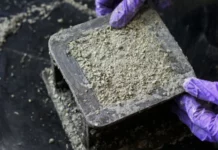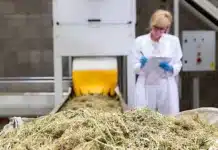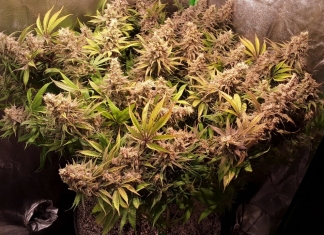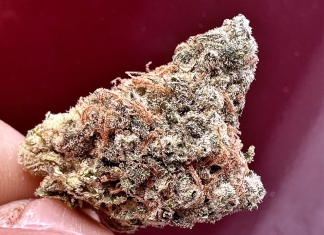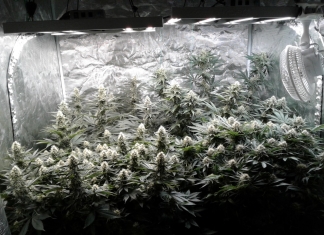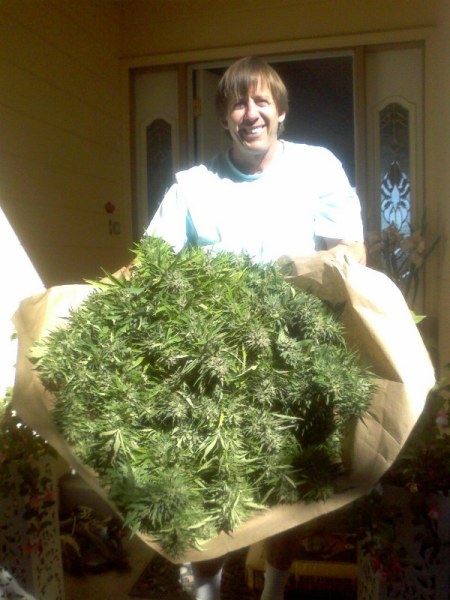In 2014, after growing industrial hemp in the U.S. became legal for the first time in almost five decades, organic farmer John Bell applied for a permit and planted a few acres on his 550-acre family farm in central Kentucky.
Even though his grandfather cultivated hemp on the same rolling hills during World War II, his father wasn’t legally able to. As a result, the 48-year-old has faced a steep learning curve since he put the first seeds in the ground four seasons ago. “I didn’t inherit the knowledge,” Bell said.
Despite low yields, Bell plans to keep trying. “I see that it can grow here,” he said. Plus, $1,000 to $3,000 he’s earning per successful acre makes wrestling with the crop a worthwhile pursuit.
Despite questions of legality, the market for hemp products—body-care products like soaps and lotions, edible items like hemp milk and shelled hemp seeds, and industrial products like building materials and auto parts—existed even before the 2014 legislation. In 2013, in fact, their sales exceeded $581 million. While most were imported, some were manufactured domestically using raw or processed hemp brought in from China, Romania, Hungary, India, and other European countries.
Then after decades of prohibition, a provision in the 2014 Farm Bill legalized growing the crop under a strict set of circumstances, allowing farmers, for the first time in decades, to profit from the demand for hemp goods—and setting the long-dormant U.S. hemp industry in motion once again.
Since then, American farmers—as well as processors and manufacturers—have been experimenting with the crop in an effort to lay the foundation for a vibrant domestic industry that, by 2016, had grown to $688 million. Although there are still huge gaps in knowledge and infrastructure, many hope that hemp can provide small-scale farmers in rural communities, many of whom are struggling to stay on the land, a high-value cash crop and a new plant to add to their rotations.
Eric Steenstra, president of Vote Hemp, a nonprofit advocating for a free market for industrial hemp, believes if the crop becomes fully legal, it could have a large, positive impact on rural America.
Farmer John Bell agrees. “If some form of industrial hemp offers a high-profit potential on a small acreage, that would be a huge help to the agricultural economy of Kentucky, because we are still looking for ways to replace the decreased tobacco production,” he said.
In addition to diversifying farmers’ operations and offering the potential for high profits, Steenstra says the crop could create new farming and manufacturing jobs across the rural parts of the country. While Vote Hemp does not have exact job growth numbers, states like Kentucky and Colorado, which lead the country in hemp-farming acreage, have seen the biggest impact, he explained. “Many younger people are leaving rural areas, but hemp has been driving a renewed interest in farming as a career,” he said.
Now, a new bill in Congress could make industry growth possible by removing hemp’s legal hurdles, and some farmers and advocates are rushing to create and hone a sustainable approach to a new commodity monocrop.
A Long History of Prohibition
Because of its association with marijuana, hemp has a long history of prohibition. While the two plants look similar and belong to the same species, hemp contains 0.3 percent of the psychoactive chemical tetrahydrocannabinol (THC), compared to marijuana’s 5 to 35 percent, and does not produce a high.
The fibrous plant once grew bountifully across the U.S., including on the estates of George Washington and Thomas Jefferson. In 1937, Congress passed the Marihuana Tax Act, which regulated and taxed hemp at levels that made it essentially impossible to grow. During World War II, the government briefly reversed its stance and promoted hemp-fiber production—for necessities like parachutes, uniforms, tarps, and tents—but it sold off the mills and revoked the growing licenses after the war.
Some attribute the post-war prohibition to lobbying pressure from the petrochemical industry, which was developing its own industrial alternatives, and the desire to maintain cheap trade in wood and textiles; others say hemp got caught up in the War on Drugs.
Then in 1970, the Controlled Substances Act classified hemp as an illegal Schedule I drug, putting it under the jurisdiction of the U.S. Drug Enforcement Administration (DEA), and criminalizing its cultivation. The domestic hemp industry, already miniscule, disappeared.
Four decades later, the 2014 Farm Bill provision allowed farmers to grow the crop for research purposes as part of a five-year agricultural pilot program, provided they’re in one of the 34 states that has passed legislation allowing the production of industrial hemp and they work in partnership with a university or state department of agriculture.
As a result, between 2016 and 2017, the number of U.S. hemp acres more than doubled from 9,700 to more than 23,000, according to a Vote Hemp crop report, with Colorado, Oregon, North Dakota, Kentucky, and New York leading the pack.
Despite this progress, the possibility that the government will one day retract its permission looms large—especially under the current administration. The DEA, in fact, continues to oppose the full legalization of industrial hemp, reasoning that enforcing drug laws would be more difficult for federal agents if farmers opted to hide marijuana plants in their hemp fields. Farmers and hemp advocates point out, however, that the risk of cross pollination, which degrades marijuana’s effect as a drug, makes this a very bad idea.
In January, U.S. Attorney General Jeff Sessions announced that the Department of Justice would rescind an Obama-era policy that discouraged federal prosecutors from aggressively enforcing federal drug laws in states where producing and selling marijuana is legal.
Then, in February, Greg Ibach, USDA undersecretary for marketing and regulatory programs, offered the Trump administration’s most thorough statement on the crop yet, saying he doesn’t necessarily want to see the “fairly narrow” regulations on hemp broadened under the next farm bill.
“Opening the door wide open nationwide, with no restrictions, may not be in the best interests of the hemp industry,” Ibach told the media after the Governor’s Forum on Colorado Agriculture in Denver. “We need to be careful so that we don’t kill the market for hemp by overburdening the market with supply before there is demand for it.”
Ibach also said he believes the U.S. Department of Justice, which includes the DEA, should continue overseeing the crop’s regulation.
As many hemp advocates see it, the House Resolution 3530, the Industrial Hemp Farming Act of 2017, currently sitting in the U.S. House of Representatives’ judiciary committee, may be the key to the industry’s long-term success. Independent from the farm bill provision that established the pilot program, the resolution would remove industrial hemp from the Controlled Substances Act and place it under the jurisdiction of the U.S. Food and Drug Administration (FDA).
The Hemp Industries Association (HIA), a leading, decades-old industrial hemp trade group, said despite justice department opposition, they expect industrial hemp business activities “will continue to expand and flourish in the U.S.”
“If anything, the threat by the Department of Justice to crack down on state-legal marijuana could result in spurring Congress to once and for all act to fully and finally protect the growth and expansion of the new American hemp economy,” said Joy Beckerman, vice president of the HIA board, in a statement.
A Miracle Crop?
Hemp is an extremely versatile plant. The seed, which has a nutty taste, is especially rich in vitamins, minerals, protein, and fiber and can be eaten roasted, made into oil, milk, or tea, and infused in beverages. It is also used in skin- and hair-care products, paper, fabric, textiles, and auto parts. Some builders are even beginning to use hempcrete, a non-toxic fireproof composite material made of hemp and limestone.
Notably, the oil from the flower can be used to produce cannabidiol, or CBD, a non-altering compound that clinical trials have shown can treat epilepsy. Studies and anecdotal evidence also suggest oils, tinctures, creams, capsules, and lotions containing CBDs can be used to treat conditions that range from anxiety to schizophrenia to cancer, although the FDA prohibits companies from marketing non-FDA-approved products as “dietary supplements.” This profitable and fastest-growing market is poised to grow at an estimated 55 percent each year and hit the $1 billion mark within three years.
As an agricultural crop, hemp has a number of benefits as well. It is a high-yield plant with a short, 120-day harvest cycle; it suppresses weeds; and it’s easier on the land, air, and water than many other crops as it requires minimal fertilizer, no chemical pesticides, and less water than crops like cotton.
Anishinaabe author and environmental activist Winona LaDuke is planting hemp on land she owns near White Earth Reservation in Minnesota in part because it is less toxic and friendlier to the earth than cotton- or petroleum-based fibers. And although the U.S. Department of Agriculture (USDA) has flip-flopped several times regarding organic certification, the agency currently allows hemp farmers to certify their acreage.
The first harvest of certified organic hemp following the latest allowance took place in 2017 , but apprehension about the process remains, limiting the number of farmers striving toward the certification.
“If it falls off the Controlled Substances Act, there’s going to be a whole new set of criteria,” said Chad Rosen, founder of Victory Hemp Foods, a producer of non-GMO hemp food products including hemp oil, protein powder, and hemp “hearts,” or hulled seeds, in Henry County, Kentucky. “There’s a let’s-wait attitude before we spend any money [on creating, publicizing, and enforcing rules].”
Still, while the majority of the hemp grown in the U.S. is not certified organic, the fact the Environmental Protection Agency (EPA) has not approved any pesticides for use with hemp means the crop, at least in theory, is largely grown chemical-free. For its part, Victory Foods sources its raw ingredients from farms that follow organic protocol, though only 25 percent are USDA-certified organic.
On the bright side, hemp production could help herald in a time when fewer farmers rely on a two-crop rotation of corn and soy, year over year. Growing a three (or more) crops in a farm’s rotation has been shown to improve yields, reduce soil erosion, and reduce the need for herbicide and fertilizer by as much as half.
“If we can begin to incorporate [hemp] into a five-year rotation with other row crops,” said Rosen, “we can see some regeneration of soil and some remediation of fields that were grown using chemical herbicides and fertilizers.”
Additionally, John Bell believes that “adding to the ecological and economic diversity” on farms is good for farmers. “The more diverse your rotation is, the fewer inputs you need to control weeds or insects or pests, because there’s less chance of any one pest, disease, insect, or weed having the environment suited to it year in and year out.” Plus, by adding a fourth crop to the corn, soybean, small-grain rotation, “risk is spread over four [crops], not three,” he said. “You don’t have as many eggs in one basket.”
Gaps in Knowledge (and Genetics)
Hemp has “definitely come a very long way” in the last four years, said Erica McBride, president of the National Hemp Association. But, she added, “It still has a long way to go.”
John Bell planted hemp at Elmwood Stock Farms after a Kentucky-based hemp food and CBD producer approached him about growing it for them in 2014. After four seasons, he’s only seen moderate success. While a few stands have been vigorous, others have failed to germinate, gotten parched by the heat, or flooded by the rains. “It’s not a throw-it-out-there-and-it-will-grow type of thing,” he said.
After North Carolina farmer Tony Finch received a grant to replace a percentage of his tobacco acreage with other crops, he planted 61 acres of hemp and began learning what not to do. “Somebody said, ‘Thomas Edison found a thousand-some ways to not make a light bulb’—it’s kind of the same principle,” he said. “There’s been generations of farmers perfecting growing tobacco. The knowledge and infrastructure was all there. Now, we’ve got to do the same thing for hemp, because the money is there.”
One part of the problem is the bureaucracy: the seeds, imported from Canada and distributed by the state, come to him—and all the other farmers Civil Eats talked to—many weeks after the ideal planting window.
Steenstra of Vote Hemp also bemoans the lack of diverse seed genetics as one of the biggest challenges facing the industry. “After World War II, there was no more effort to continue or maintain or develop varieties of hemp for the U.S. market,” he said. “We’ve lost the genetics and have to start over.”
Laura Freeman of Mt. Folly Farm, a mid-sized organic farm specializing in beef and grain near Winchester, Kentucky, planted 12 acres of organic hemp three years ago. When the planting yielded only two bushels, Freeman sought a productive use of the meager harvest—and developed a line of chocolates out of hemp, taking advantage of the seed’s nutritional content.
Regardless of the low yield, Freeman, too, recognizes the crop’s potential and plans to stick with it. “It’s a great plant—the nutrient value of the hemp seed really is there,” she said. “All the agronomics problems can be overcome with decreased bureaucracy, seed that’s adapted to the state, and better organic understanding on our part.”
Once farmers figure it out, she said, “Then you have another crop, [similar to] a small grain, you can put in the organic rotation—which we need badly.”
Holes in the Supply Chain
In addition to gaps in knowledge, vital components of the hemp supply chain are also missing. Across all sectors of the industry, people are wary of fully committing to industrial hemp until the government considers it a commodity crop rather than a controlled substance on par with marijuana, LSD, and heroin.
“There’s a feeling it could become more than just a pilot program and legal for anyone to grow pretty soon—or it could be shut down,” said Bell. “Until the ability to grow it is a little more certain, I’m not going to build a rotation around it.”
U.S. players’ lack of commitment to—and therefore investment in—hemp also means vital pieces of processing infrastructure are missing, especially when it comes to fiber. On the nutrition-product side, farmers can adapt for hemp the tools and machinery used to harvest and process other types of seeds. And for his CBD crop, Bell was able to use old tobacco barns on his property to cure and dry the flowers before sending them to the processor.
But hemp is much bulkier and tougher than other types of fiber, and traditional fiber machinery cannot handle it. For the hemp fiber industry to take off, experts say, American processors will need to invest in expensive, commercial-scale decortication equipment that strips the fiber from the stalk. Though this type of machine is nearly nonexistent in the U.S., Hemp, Inc. opened a 85,000 square foot industrial hemp processing facility in Spring Hope, North Carolina in 2017 and plans to get decortication equipment up and running this year.
Rosen’s company is one of the only in the U.S. that sources 100 percent of its hemp from American farmers. Doing so has required him to build a supply chain—basically from scratch. In addition to working with contracted farmers to figure out which seeds to plant, what amendments to add to the soil, and how to harvest, dry, clean, and process the plant, Victory Hemp Foods has also created its own label under which to sell the product.
“We’re straddling an enormous part of the value chain,” Rosen said. “I don’t think we realized we’d have to do quite so much.”
Over the last few years, Rosen has realized a good level of success despite the challenges: Victory’s hemp ingredients line the shelves of Kroger, Whole Foods, and independent food retailers in the Kentucky region; Severino pasta uses Victory-processed ingredients; and Smiling Hara uses Victory hemp to create a hemp tempeh (“hempeh”). In addition, Victory just purchased a processing facility in Vermont that once manufactured canola and sunflower oil, which will increase its capacity to process hemp seed by a factor of 20.
It has been a lot of work, Rosen said, but on the bright side, “it’s allowed us to dialogue with the market and carry the conversation all the way through. People like knowing where their food comes from, and we’re able to accomplish that.”
Fully and Finally Legal?
Erica McBride of the NHA sees people’s lack of ability to see hemp as distinct from with marijuana as the main factor working against the promising crop. “Honestly, I think a majority of it is simply a lack of education,” she said. “People don’t understand the difference … and they don’t understand the economic impact this would have for farmers and for manufacturing job creation. Once you can sit down with the naysayers and explain things to them, they usually do come around.”
Steenstra of Vote Hemp hopes a few provisions of HR 3530 will be revised—including one that allows the DEA to conduct administrative inspections—but overall, he feels optimistic about the bill’s prospects of passing this session.
The bill enjoys bipartisan support, he said, and the chair of the House judiciary committee, Bob Goodlatte (R-VA), became a co-sponsor this year; additionally, representatives James Comer (R-KY) and Jared Polis (D-CO), as well as senators Ron Wyden (D-OR) and Mitch McConnell (R-KY) count among its supporters. “I believe the bill has a path to passage,” he said.
Though she’s not certain of the timeline given the current climate on Capitol Hill, McBride also feels confident the bill will pass once it gets to a vote. Once it’s no longer considered a drug, she said, “there won’t be the trepidation on either side, farming or manufacturing. That will open up everything.”
A Word of Caution as Industry Develops
Though hemp advocates see great potential for the crop, Victory Hemp Foods’ Rosen believes the industry needs to grow thoughtfully and sustainably for the crop to offer real solutions for farmers and the environment.
“If we think hemp is the be-all-end-all solution in terms of regenerative agricultural practices, we’re gravely mistaken,” he said. “Hemp is just another crop, and we don’t want monoculture crops—look what corn and soy got us. It has to be [developed] responsibly.”
Rosen predicts that as soon as the crop falls off the Controlled Substances Act, major agriculture companies could move in. “There’s no way the Big Six [seed and pesticide companies] are going to sit on the sidelines and watch this incredibly valuable commodity crop come into the rotation,” he said. “If farmers say, ‘We’ve got weed problems—can you splice DNA in there that allows it to resist glyphosate?’ we’ve lost.”
McBride of the NHA is also looking ahead to prepare for a legal-hemp future, but she sees Big Ag’s involvement as further off. “I don’t think Big Ag is going to jump in as soon as the bill passes—right now there is not a market to support them,” she said. “My hope is that by the time the markets are built, enough smaller farmers will be engaged to meet the supply and [that will keep] the advantage to small-to-medium-sized producers.”
Farmer John Bell believes that even if Big Ag does adopts hemp, which seems likely, he’s encouraged by the fact that it could still means third our fourth rotation on farms that have only grown corn and soy in recent years.
For the time being, Rosen encourages sustainable hemp proponents to get out ahead of the game—and figure out how to grow it well and meet the market without the need for the standard quantity of pesticides and synthetic fertilizers associated with most commodity crops.
“We can advocate, and run hard and fast, and carve a path they can follow us in,” he said. “Make no mistake about it, this is a race against time.”



